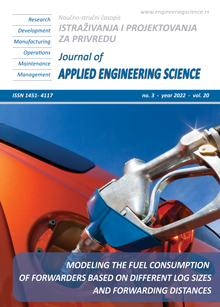ON-GRID AND HYBRID SOLAR POWER PLANTS COMPARABILITY IN SEMARANG CITY, INDONESIA
Abstract
The electricity produced by an on-grid system can be sold to the state electricity company in Indonesian (PLN), when electricity produced by a hybrid system can be stored in batteries for self-consumption. This research will compare the savings between on-grid and hybrid system with the most profitable between both systems. The research method will utilize a simulation on PVSyst software for assessing technical feasibility and Retscreen software to calculate economic feasibility. The research results are obtained based on the comparison of both systems which are the Hybrid system used with a 1,200 Wp panel, 2 series 24V 100 Ah batteries, and a 1,500 W inverter, while On-grid system uses a 1,200 Wp panel and 1,500 W inverter. The On-grid design will produce electrical energy of 4,57 kWh/kWp/day with an initial investment value of USD 1,733.70 while the Hybrid design will produce 4,04 kWh/Kwp/day with an initial investment value of USD 1,871.63 for a 24 years project period and with approximately four times batteries replacement. The NPV value in the Hybrid system calculated is USD 1.43 and in the On-grid system is USD 1,700. Therefore, the Hybrid system is considered not economically feasible and does not gain more profit than On-grid System.
References
M. A. McNeil, N. Karali, and V. Letschert, “Forecasting Indonesia’s electricity load through 2030 and peak demand reductions from appliance and lighting efficiency,” Energy Sustain. Dev., vol. 49, pp. 65–77, 2019, doi: 10.1016/j.esd.2019.01.001.
N. A. Handayani and D. Ariyanti, “Potency of Solar Energy Applications in Indonesia,” Int. J. Renew. Energy Dev., vol. 1, no. 2, pp. 33–38, 2012, doi: 10.14710/ijred.1.2.33-38.
Tim Sekretaris Jenderal Dewan Energi Nasional, “Outlook Energi Indonesia 2019,” 2019, [Online]. Available: https://www.esdm.go.id/assets/media/content/content-outlook-energi-indonesia-2019-bahasa-indonesia.pdf.>
S. Zheng, G. Huang, and A. C. Lai, “Techno-economic performance analysis of synergistic energy sharing strategies for grid-connected prosumers with distributed battery storages,” Renew. Energy, vol. 178, pp. 1261–1278, 2021, doi: 10.1016/j.renene.2021.06.100.
M. A. Omar and M. M. Mahmoud, “Grid connected PV- home systems in Palestine: A review on technical performance, effects and economic feasibility,” Renew. Sustain. Energy Rev., vol. 82, pp. 2490–2497, Feb. 2018, doi: 10.1016/J.RSER.2017.09.008.
I. Hernanda, R. Fairuz, and E. A. Setiawan, “Techno economic analysis photovoltaic on-grid system Java bali to optimize PLN energy consumption,” E3S Web Conf., vol. 67, pp. 1–5, 2018, doi: 10.1051/e3sconf/20186702050.
M. Sadi and A. Arabkoohsar, “Modelling and analysis of a hybrid solar concentrating-waste incineration power plant,” J. Clean. Prod., vol. 216, pp. 570–584, Apr. 2019, doi: 10.1016/J.JCLEPRO.2018.12.055.
L. Jia, X. Chen, S. Cao, and H. Yang, “Overview on hybrid solar photovoltaic-electrical energy storage technologies for power supply to buildings,” Energy Convers. Manag., vol. 187, pp. 103–121, 2019, doi: 10.1016/j.enconman.2019.02.080.
F. Perdiansyah, E. T. N. Fitriana, N. Aziema, P. P. Maharani, F. Khoerunnisa, and N. Winarno, “The Efficient Implementation of Hybrid Power Plants in Indonesia,” Indones. J. Multidiscip. Res., vol. 1, no. 2, pp. 67–74, 2021, [Online]. Available: https://ejournal.upi.edu/index.php/IJOMR/article/view/33772.>
Head of Bureau of Communication Public Information Services and Communication, “Electricity Tariffs for April-June 2021 Remain Unchanged,” Minist. Energy Miner. Resour. Press Release, Mar. 2021, [Online]. Available: https://www.esdm.go.id/en/media-center/news-archives/electricity-tariffs-for-april-june-2021-remain-unchanged.>
Menteri Energi dan Sumber Daya Mineral Republik Indonesia, “Peraturan Menteri Energi Dan Sumber Daya Mineral Republik Indonesia Nomor 26 Tahun 2021 About Rooftop Solar Power Plants Connected to the Electric Power Network Holders of Business Licenses for the Provision of Electricity for Public Interest,” Kementeri. Energi dan Sumber Daya Miner. Republik Indones., 2021, [Online]. Available: https://legalitas.org/download/write_pdf.php?url=pdf/peraturan_menteri/kementerian_energi_dan_sumber_daya_mineral/2021/Peraturan-Menteri-Kementerian-Energi-Dan-Sumber-Daya-Mineral-26-tahun-2021.pdf.>
K. R. Khalilpour and A. Vassallo, “Technoeconomic parametric analysis of PV-battery systems,” Renew. Energy, vol. 97, pp. 757–768, 2016, doi: 10.1016/j.renene.2016.06.010.
Y. Li, W. Gao, and Y. Ruan, “Performance investigation of grid-connected residential PV-battery system focusing on enhancing self-consumption and peak shaving in Kyushu, Japan,” Renew. Energy, vol. 127, pp. 514–523, 2018, doi: 10.1016/j.renene.2018.04.074.
M. M. Mahmoud and I. H. Ibrik, “Techno-economic feasibility of energy supply of remote villages in Palestine by PV-systems, diesel generators and electric grid,” Renew. Sustain. Energy Rev., vol. 10, no. 2, pp. 128–138, Apr. 2006, doi: 10.1016/J.RSER.2004.09.001.
J. Windarta, S. Saptadi, Denis, D. A. Satrio, and J. S. Silaen, “Technical Analysis on Household-Scale Rooftop Solar Power Plant Design with On-Grid System in Semarang City,” in The 5th International Conference on Energy, Environment, Epidemiology and Information System (ICENIS), 2020, vol. 202, doi: 10.1051/e3sconf/202020208006.
International Financial Corporation, “Utility-Scale Solar Photovoltaic Power Plants,” 2015. https://www.ifc.org/wps/wcm/connect/a1b3dbd3-983e-4ee3-a67b-cdc29ef900cb/IFC+Solar+Report_Web+_08+05.pdf?MOD=AJPERES&CVID=kZePDPG.>
“Inflation,” Monetary Data Bank Indonesia, 2021. https://www.bi.go.id/en/fungsi-utama/moneter/inflasi/Default.aspx (accessed Aug. 01, 2021).
I. N. Pujawan, Ekonomi Teknik Edisi 3. Yogyakarta: LAUTAN PUSTAKA, 2019.
C. H. B. Apribowo, M. Nizam, S. Pramono, H. Maghfiroh, and K. Hakim, “Design and Analysis Performance Solar Power Plant 15 {kW} By Maximizing Final Yield and Performance Ratio In Small-Medium Office,” {IOP} Conf. Ser. Mater. Sci. Eng., vol. 1096, no. 1, p. 12082, Mar. 2021, doi: 10.1088/1757-899x/1096/1/012082.
E. Sukma Wahyuni, H. Mubarok, F. Nur Budiman, and S. Wahyu Pratomo, “Pemanfaatan Energi Terbarukan untuk Pembangkit Listrik Tenaga Surya Berbasis Komunitas: Menuju Desa Mandiri Energi,” Engagem. J. Pengabdi. Kpd. Masy., vol. 4, no. 2, pp. 493–508, 2020, doi: 10.29062/engagement.v4i2.181.
J. Windarta, S. Saptadi, Denis, D. A. Satrio, and J. S. Silaen, “Economic Feasibility Analysis of Rooftop Solar Power Plant Design with Household-Scale On-Grid System in Semarang City,” 2020, doi: 10.1051/e3sconf/202020209002.

